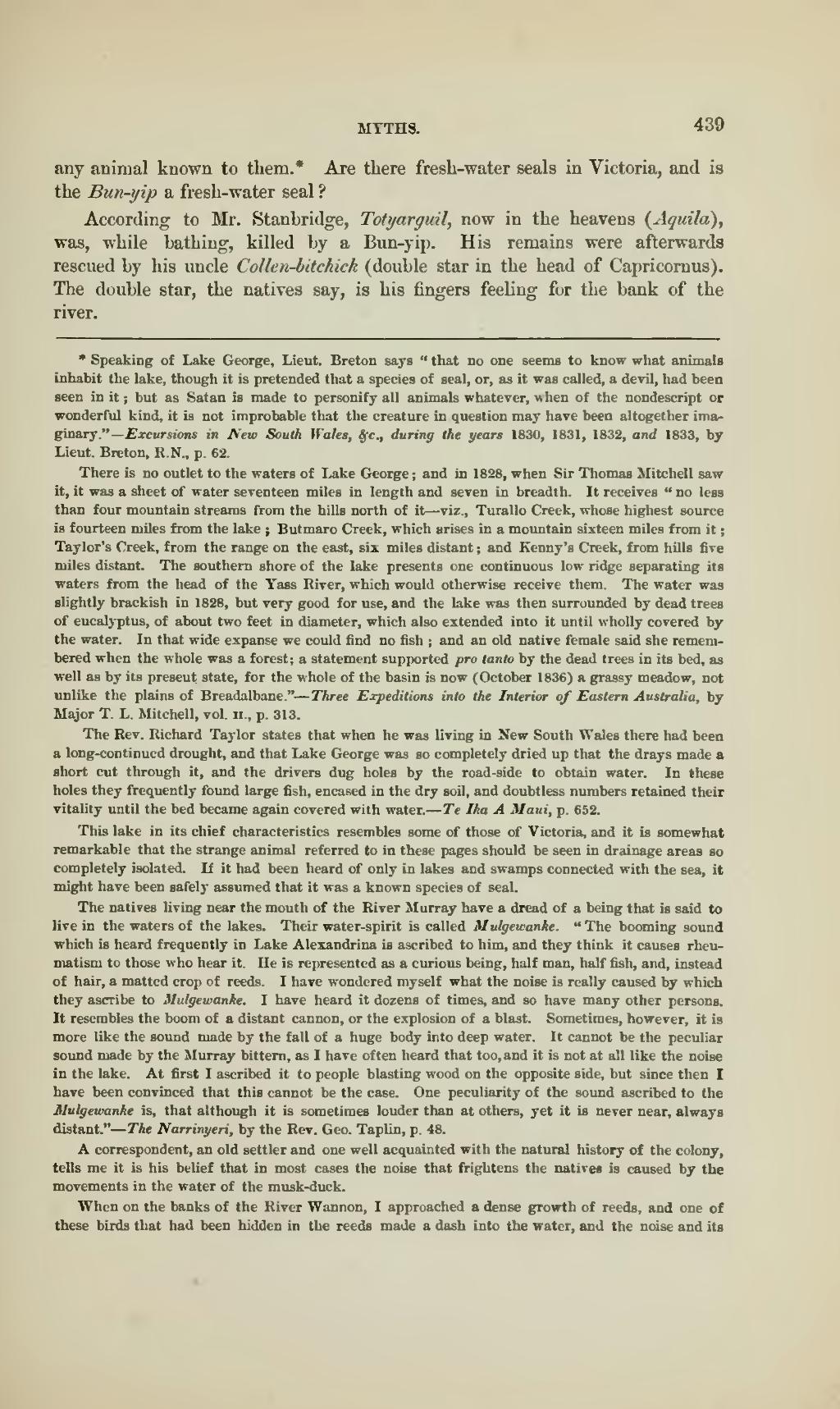This page has been validated.
MYTHS.
439
any animal known to them.[1] Are there fresh-water seals in Victoria, and is the Bun-yip a fresh-water seal?
According to Mr. Stanbridge, Totyarguil, now in the heavens (Aquila), was, while bathing, killed by a Bun-yip. His remains were afterwards rescued by his uncle Collen-bitchick (double star in the head of Capricornus). The double star, the natives say, is his fingers feeling for the bank of the river.
- ↑ Speaking of Lake George, Lieut. Breton says "that no one seems to know what animals inhabit the lake, though it is pretended that a species of seal, or, as it was called, a devil, had been seen in it; but as Satan is made to personify all animals whatever, when of the nondescript or wonderful kind, it is not improbable that the creature in question may have been altogether imaginary."—Excursions in New South Wales, &c., during the years 1830, 1831, 1832, and 1833, by Lieut. Breton, R.N., p. 62. There is no outlet to the waters of Lake George; and in 1828, when Sir Thomas Mitchell saw it, it was a sheet of water seventeen miles in length and seven in breadth. It receives "no less than four mountain streams from the hills north of it—viz., Turallo Creek, whose highest source is fourteen miles from the lake; Butmaro Creek, which arises in a mountain sixteen miles from it; Taylor's Creek, from the range on the east, six miles distant; and Kenny's Creek, from hills five miles distant. The southern shore of the lake presents one continuous low ridge separating its waters from the head of the Yass River, which would otherwise receive them. The water was slightly brackish in 1828, but very good for use, and the lake was then surrounded by dead trees of eucalyptus, of about two feet in diameter, which also extended into it until wholly covered by the water. In that wide expanse we could find no fish; and an old native female said she remembered when the whole was a forest; a statement supported pro tanto by the dead trees in its bed, as well as by its preseut state, for the whole of the basin is now (October 1836) a grassy meadow, not unlike the plains of Breadalbane."—Three Expeditions into the Interior of Eastern Australia, by Major T. L. Mitchell, vol. II., p. 313. The Rev. Richard Taylor states that when he was living in New South Wales there had been a long-continued drought, and that Lake George was so completely dried up that the drays made a short cut through it, and the drivers dug holes by the road-side to obtain water. In these holes they frequently found large fish, encased in the dry soil, and doubtless numbers retained their vitality until the bed became again covered with water.—Te Ika A Maui, p. 652. This lake in its chief characteristics resembles some of those of Victoria, and it is somewhat remarkable that the strange animal referred to in these pages should be seen in drainage areas so completely isolated. If it had been heard of only in lakes and swamps connected with the sea, it might have been safely assumed that it was a known species of seal. The natives living near the mouth of the River Murray have a dread of a being that is said to live in the waters of the lakes. Their water-spirit is called Mulgewanke. "The booming sound which is heard frequently in Lake Alexandrina is ascribed to him, and they think it causes rheumatism to those who hear it. He is represented as a curious being, half man, half fish, and, instead of hair, a matted crop of reeds. I have wondered myself what the noise is really caused by which they ascribe to Mulgewanke. I have heard it dozens of times, and so have many other persons. It resembles the boom of a distant cannon, or the explosion of a blast. Sometimes, however, it is more like the sound made by the fall of a huge body into deep water. It cannot be the peculiar sound made by the Murray bittern, as I have often heard that too, and it is not at all like the noise in the lake. At first I ascribed it to people blasting wood on the opposite side, but since then I have been convinced that this cannot be the case. One peculiarity of the sound ascribed to the Mulgewanke is, that although it is sometimes louder than at others, yet it is never near, always distant."—The Narrinyeri, by the Rev. Geo. Taplin, p. 48. A correspondent, an old settler and one well acquainted with the natural history of the colony, tells me it is his belief that in most cases the noise that frightens the natives is caused by the movements in the water of the musk-duck. When on the banks of the River Wannon, I approached a dense growth of reeds, and one of these birds that had been hidden in the reeds made a dash into the water, and the noise and its

